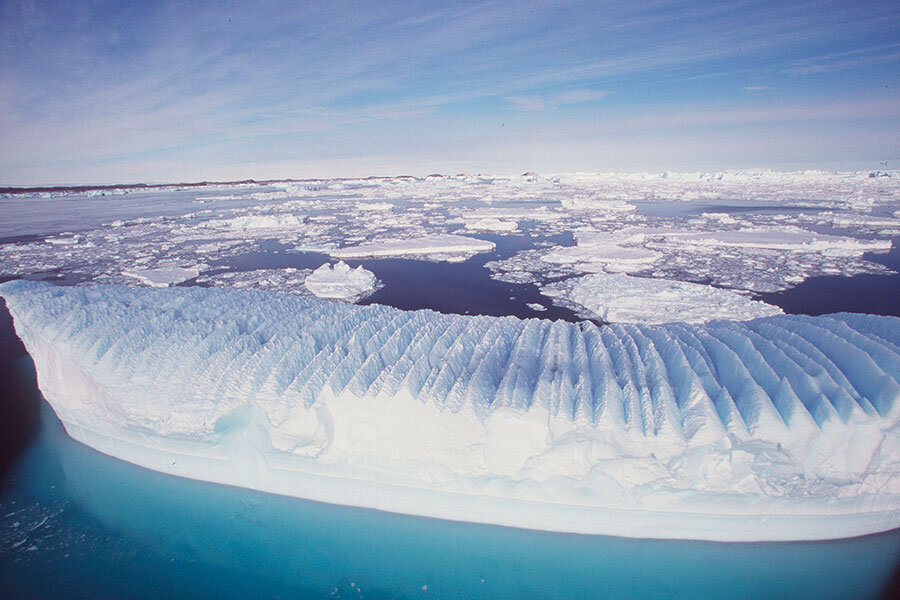Nature's global warming 'sink' isn't clogged anymore, studies say
Loading...
After an unexpected lull, Earth's Southern Ocean – a vast marine moat surrounding Antarctica – is pulling carbon dioxide out of the atmosphere at an increased clip.
The trend should ease concerns that the Southern Ocean may be losing its capacity to scrub CO2, a climate-altering greenhouse gas, from the atmosphere.
It also highlights how much remains to be learned about the factors governing CO2 uptake in Southern Ocean, researchers say.
By some estimates, the Southern Ocean accounts for 43 percent of the total ocean uptake of CO2 emissions humans pump into the atmosphere. But the controls on that uptake and their interplay are poorly understood. Solving those puzzles would put estimates of the ocean's response to continued global warming on a more sound footing, researchers say.
Concerns about the slowdown emerged eight years ago after a team of scientists reported that the uptake had eased between 1981 and 2004. The team suggested that the change was a byproduct of global warming and Antarctica's ozone hole, which combined to weaken the prevailing westerly winds over the Southern Ocean.
If the slowdown in winds, and thus in CO2 uptake, continued for a long period of time, would leave more of the greenhouse gas in the atmosphere to drive global warming
With more data in hand, it now appears that the slowdown ended in 2002, according to two new studies. By 2012 the Southern Ocean's CO2 uptake had returned to pre-slowdown levels.
Going into 2002, it looked as though the Southern Ocean was taking up about 600 million tons of CO2 a year, and by 2011 that rate had nearly doubled, notes Colm Sweeney, an researcher at the National Oceanic and Atmospheric Administration's Earth Systems Research Laboratory in Boulder, Colo.
During the next 10 years, "it got caught up and is back to where we think it should be," says Dr. Sweeney, who took part in both studies.
One study collected data in and around the Drake Passage, an expanse of Southern Ocean that stretches from the southern tip of South America to the West Antarctic Peninsula. It shows that region has been increasing its uptake of CO2 between since 2002.
The change in uptake is most pronounced in winter in waters above about 62 or 63 degrees south. There, the water is coldest, which allows it to absorb more CO2. Also, deep water that has not had contact with the atmosphere for centuries is able to absorb more CO2 than would otherwise be the case.
The analysis was published this week in Geophysical Research Letters.
The second study, published in the journal Science, looked at the Southern Ocean as a whole and found that the slowdown ended in 2002 and by 2012 was back to levels researchers expected to see.
The team, led by Peter Landschützer, a researcher with ETH Zurich, a university in Switzerland, found intriguing regional differences in how sea-surface temperatures and water chemistry influenced uptake throughout the Southern Ocean. The researchers suggested that these differences could be tied to natural modes of climate variability in the Pacific and Atlantic. Since the modes swing back and forth over time, the team posits that the Southern Ocean's uptake may also vary with them.
The possibility that the Southern Ocean has undergone a turnaround in its CO2-scrubbing performance "is pretty darned interesting," says Jorge Sarmiento, a professor at Princeton University whose research has long focused on the ocean carbon cycle.
The reduction was modest, he says. But because of the Southern Ocean's importance as a carbon "sink" the topic "drew a huge amount of attention."
He cautions, however, that these latest results are not rock-solid proof.
For one thing, the data are "incredibly sparse in the Southern Ocean in time and in space," he says. For another, work one of his graduate students has done using different methods and assumptions shows that the Southern Ocean's uptake never flagged.
Other studies also have suggested that the slowdown never happened, he notes.
At the least, all of these efforts indicate the need for year-around sampling in the Southern Ocean and over a much wider area.
Some help is coming from a series of floats being designed and tested as part of the Southern Ocean Carbon Climate and Observations Modeling (SOCCOM).
The project was inspired by a global effort that uses some 3,880 floats to gauge temperature and salinity in the upper 6,500 feet of the world's oceans.
SOCCOM, which Dr. Sarmiento heads, aims to pepper the Southern Ocean with another 200 floats designed to take measurements that have a bearing on the ocean's ability to act as a CO2 sink. These include dissolved oxygen, nutrients, as well as pH, which yields information for estimating the CO2 exchange between the ocean and atmosphere. The 200 floats are expected to sample between 500 and 700 locations a month.
A long-term monitoring program would be ideal, Sarmiento says, but adds that even a few years of data "would be a major achievement" in understanding the Southern Ocean's carbon cycle.
[Editor's note: Several facts have been corrected from the original version: 1) the percentage of total global ocean uptake of CO2 by the Southern Ocean, 2) the estimates of how much CO2 was taken up by the Southern Ocean in 2002 and 2011, and 3) the nature of the uptake at the lowest southern latitudes.]





